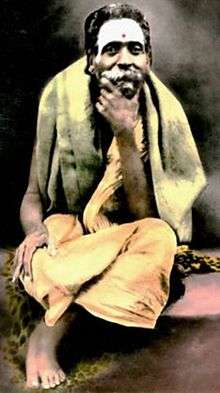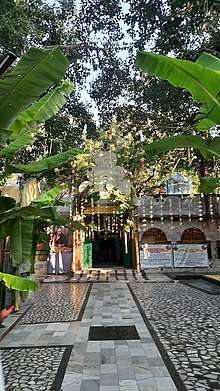Seshadri Swamigal
Sri Seshadri Swamigal, also known as the "Saint with a golden hand", was an Indian saint who lived in Thiruvannaamalai.
Sri Seshadri Swamigal | |
|---|---|
 Seshadri Swamigal | |
| Personal | |
| Born | Seshadri Kamakoti Sastri 22 January 1870 Thondai Mandalam |
| Died | 4 January 1929 Arunachala |
| Religion | Hinduism |
Life
Childhood
Seshadri Swamigal was born on January 22, 1870. As a child he had spontaneous trances. For example, he used to sit on the lap of his father and sit with the chinmudra in a posture of meditation. At other times, when his father was teaching a class, he used to look at the book as if he was reading and comprehending it. At age four, Seshadri received his nickname, 'Golden Hand' (Tamil: Thanga Kai). One day Seshadri and his mother stopped at a shop full of bronze castings of the Gods. While at the shop the young lad picked up a statue of Krishna and asked his mother to buy it so he could perform Krishna puja. The trader, thinking that the radiant child himself resembled the Lord Krishna, gave the idol and refused payment. The next day the trader proclaimed the boy to be most lucky as the whole consignment of 1,000 statues (because of the young boy's touch), had been sold in one day. News of the incident spread quickly through the town and from that moment on the young boy was known as, 'The one with the golden hand'. This gave him the name "Thanga Kai" (golden hand).
Aged 14, his father Sri Varadarajar died unexpectedly. Kamakoti Sastrigal took the family to live at Vazhur. It was there that Swamiji completed his education. Aged 17 his mother died, and Seshadri's uncle took charge of Seshadri and the younger brother Narasimha Josiar.
Early Adulthood - the time he took sannyas
At the age of 19, he met Sri Balaji Swamigal, a wandering saint from North India, an avadut, who gave Seshadri sannyas and instructed him in the Mahavakyas, the holy sayings of the 4 Vedas. Shortly after Seshadri Swamigal started to travel to various spots in Tamil Nadu eventually ending up at Tiruvannamalai, at the age of 19. Seshadri Swamigal moved about Tiruvannamalai for 40 years, an ascetic with a total disregard for either name or form.
Throughout his life and teachings Sri Seshadri Swamigal continuously emphasised the glory of Arunachala. He often talked about the unique aspects of the Arunachala kshetra.[1] He would say: 'This is the place where Swamy and Ambal invite all and confer liberation', and 'Lord Krishna leaving aside his sudarshana chakra (divine weapon) is playing on his flute. On hearing it Lord Siva who is inside the mountain comes out and dances'.
Sri Seshadri Swamigal had deep devotion to God, especially in the form of the Goddess Kamakshi, Lord Ram and Arunachala. Sri Seshadri Swamigal was a great worshipper of Shakti. In the practice of concentration he sat steeped in samadhi, oblivious of his body.
Death
Sri Seshadri died on January 4, 1929. His body was not cremated but buried, as is the custom in the case of a saint.[2]
Seshadri Swamigal and Ramana Maharshi
Seshadri Swamigal and Ramana Maharshi were contemporaries. Seshadri actually arrived at Arunachala six years earlier than Ramana. When Ramana Maharshi came to Tiruvannamalai seven years after Seshadri Swamigal's arrival, Seshadri took care of Ramana Maharshi. Sri Seshadri tried to protect the young swami who seemed quite unaware of his body and surroundings.[3] He cleansed Ramana's blood-oozing wounds and revealed Ramana as a [saint] to the world.
Ashram and temple

The Seshadri Swamigal Ashram[4][5] is located in Tiruvannamalai, very close to Ramanasramam.

The consecration of the Sundaravadana Perumal temple in Vazhur, associated with Seshadri Swamigals birth, happened on 12 February 2012.[6]
Television Series
Based on His Life and Teachings, DD Podhigai used to telecast a Serial Named as "Sri Seshadri Swamigal Mahathmyam" every Thursday at 7.02 P.M.
References
- http://www.arunachalasamudra.org/4dm1.html
- Ramana Maharshi and the Path of Self-Knowledge
- Timeless in Time, Sri Ramana Maharshi, by A. R. Natarajan
- "Official Website of the Seshadri Swamigal Ashram". Archived from the original on 15 March 2013. Retrieved 21 January 2012.CS1 maint: BOT: original-url status unknown (link)
- Official Website of the Seshadri Swamigal Ashram - live
- Consecration of Temple associated with the birth of Seshadri Swamigal